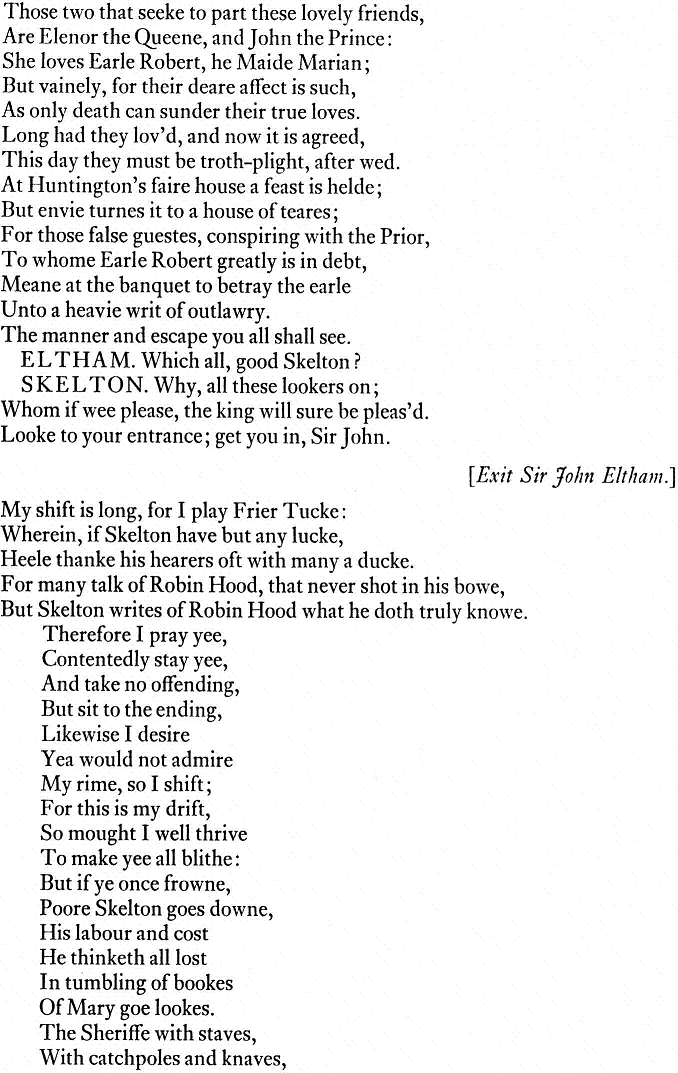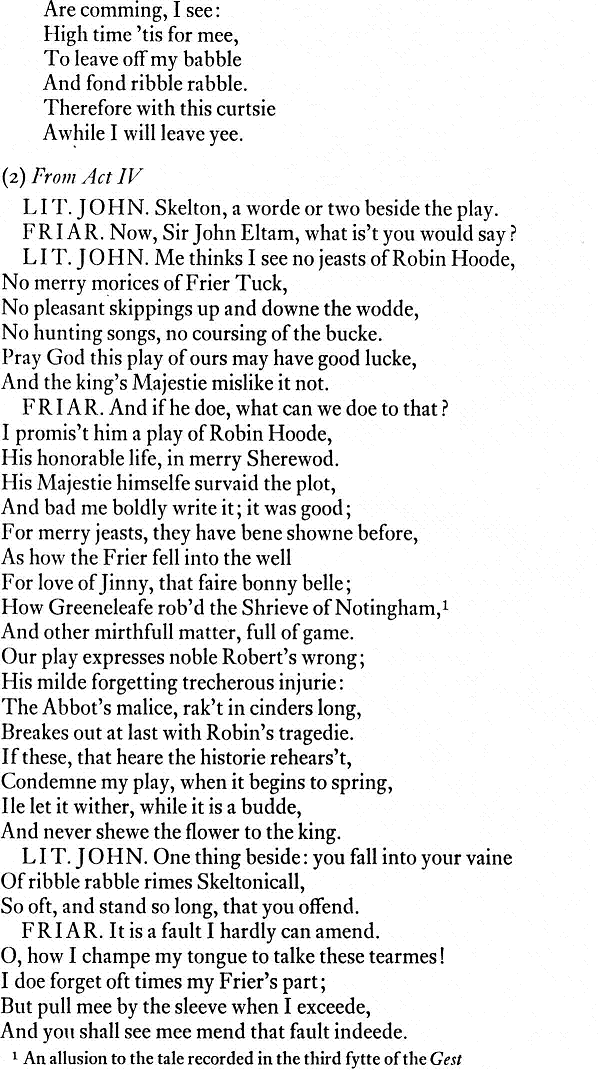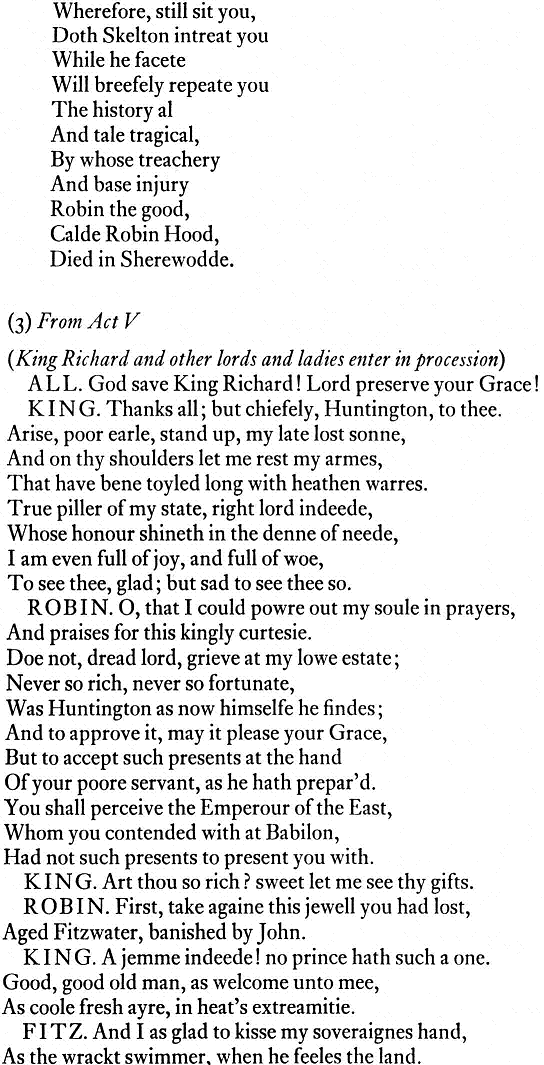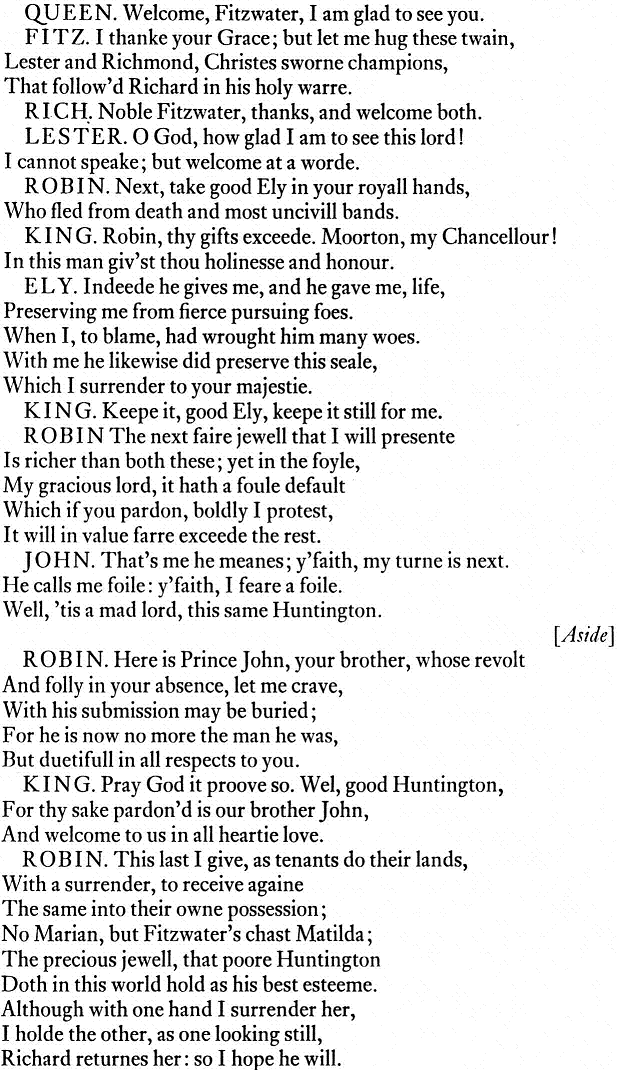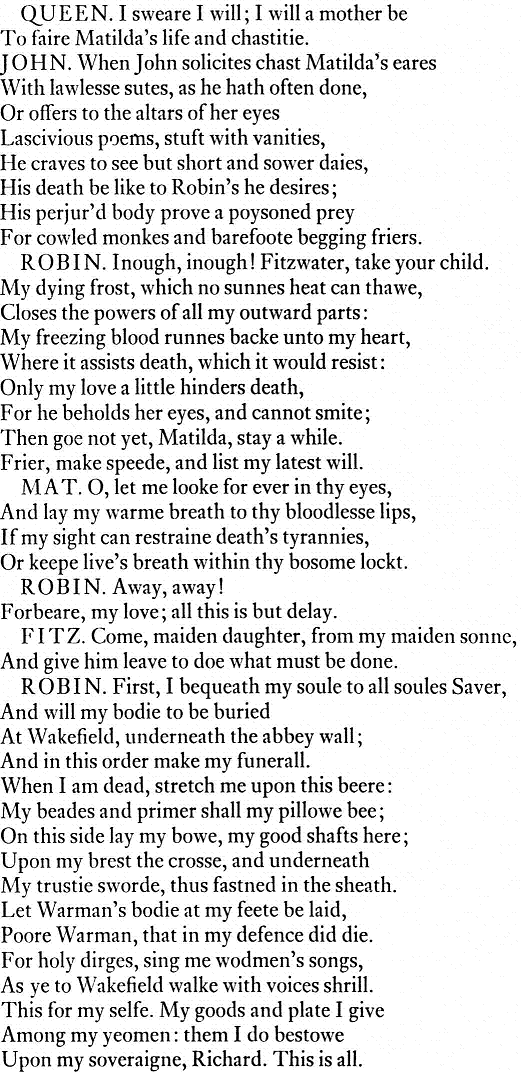The Downfall and Death of Robert, Earl of Huntington
Extracts from Anthony Munday’s ‘The Downfall of Robert, Earl of Huntington’ and ‘The Death of Robert, Earl of Huntington’ (c. 1598)
The two plays written by Anthony Munday are the most influential dramatic works about Robin Hood, and the only surviving Elizabethan plays in which the outlaw hero’s ‘career’ is dealt with at length. Munday’s ‘two partes of Robart Hoode’, has left a lasting but false impression on the greenwood saga; firstly they identify Maid Marian with one of the semi-mythical Matildas persecuted by King John, and secondly they elevate the outlaw leader to Robert, Earl of Huntington.
The Downfall of Robert, Earl of Huntington is a play within a play. In the introduction and in various parts of the drama, Sir John Eltham (who acts the part of Little John) and John Skelton (who plays the role of Friar Tuck) actually discuss the nature and problems of the play, which they are supposedly presenting before Henry VIII and his court. In Act 1 below, Skelton ‘as Prologue’ introduces the various players to his audience as they enter the stage for the first time. Robin Hood is identified as Robert Earl of Huntington, a contemporary of King Richard I who has left England to fight in the Holy Land. At the centre of the plot there is Robin’s relationship with Matilda (alias Marian), the daughter of Lord Fitzwater. The path of true love between the two characters is repeatedly thwarted by the desire of Richard’s brother prince John, for Matilda, and that of his mother, Queen Elinor, for Robin. Robin is served by an evil steward named Warman who later becomes the sheriff of Nottingham; he betrays his master to the latter’s uncle, Gilbert de Hood, Prior of York. The two conspirators, through a complicated chain of events, secure Robin’s outlawry; there are more complications involving Scarlet, Scathlock, and Much, the Miller’s Son, before a mildly happy ending is achieved on the return of King Richard at the end of the play.
In the Death of Robert, Earl of Huntington, Robin dies at the end of the first act, as a result of swallowing poison, the victim of an intrigue between his uncle, the Prior of York, and Sir Doncaster. Robin’s lingering death (Act 1 below) differs from the ballad accounts of the hero’s demise, and is the most impressive piece in the entire play. The dying Robin attempts to reconcile his former friends and enemies, who are at odds with one another as soon as John succeeds his brother Richard as king. The last four acts of the play focus on Matilda, who is pursued by the tyrant John. Lord Bruce, Matilda’s uncle, attempts to oppose John’s intrigues, which leads to the starvation of Lady Bruce and her younger son in the dungeons of Windsor Castle. Matilda takes shelter in Dunmow Abbey where she is poisioned by John’s evil henchman Brand, this brings John, at the end of the play, to a state of repentance. Robert Davenport’s King John and Matilda of 1655 borrows heavily from The Death.
It is clear that Munday used the work of his literary friends as a source for his plays – John Stow’s ‘Chronicles of England’ and Michael Drayton’s historical poem, Matilda, the Faire and Chaste Daughter of the Lord Robert Fitzwater, as well as the anonymous Troublesome Raigne of John King of England and George A Green, the Pinner of Wakefield. Other sources probably include the chronicles of Holinshed, a variety of metrical romances of King Richard and several Robin Hood ballads. The appearance of a Prior of York and of Sir Doncaster, make it clear that Munday had some knowledge of the Gest. He may have also been influenced by the chronicler Richard Grafton, who believed that Robin Hood ‘was for his manhood and chiualry aduanced to the noble dignitie of an Erle’(1). The presence of Sir John Eltham and of the poet John Skelton, together with the dramatic fiction that they are presenting a play before Henry VIII’s court, make it possible that among Munday’s sources, was a now lost May Day Robin Hood pageant or interlude, written by Skelton himself, at the beginning of the sixteenth century. In 1615, Munday introduced Robin Hood into another of his works, the Metropolis Coronata, The Triumphes of Ancient Drapery, a pageant prepared for the London Lord Mayor’s Day. Here Munday completly changed his previous characterization of Robin Hood as the son-in-law of Lord Fitzwater, to the new idea that his father-in-law was Henry Fitz-Aylwin, the first mayor of London(2). There can be no doubt that Munday’s treatment of Robin Hood, was the most imaginative and cavalier of all.
The extinction of the Elizabethan and Jacobean dramatic tradition in the 1640s, meant that many years were to elapse before Robin Hood again became a serious character on the stage. In the eighteenth century the outlaw hero found his way into a series of comic operas and farces. The highlight of the 1730 version of Robin Hood (‘An Opera, As it is Perform’d at Lee’s and Harper’s Great Theatrical Booth In Bartholomew-Fair’) was the scene in which the Pinner of Wakefield chased Little John under the table, then into a cradle for seducing his wife. Twenty years later Robin Hood made regular appearances in a ‘musical entertainment’ at Drury Lane, where he appears as a promoter of the love-affair between Leander and Clorinda, as well as the singer of a popular song entitled ‘As blithe as the linnet sings in the green wood’.(3) Most popular of all was Leonard MacNally’s comic opera Robin Hood or Sherwood Forest, which in a shortened form was performed two or three times a season at the Theatre Royal, Covent Garden, throughout the last decade of the eighteenth century(4)
1. Richard Grafton : Chronicle at Large 1569; John Leland described Robin Hood as ‘nobilis’: Leland’s Collectanea, c. 1540.
2. Metropolis Coronata (London, 1615); Ritson, 1846, pp. 19-20; DM Bergeron, English Civic Pageantry, 1558-1642 (London, 1971), pp. 152-5.
3. Robin Hood, An Opera (printed for J Watts, London, 1730); Robin Hood, A New Musical Entertainment (printed by M. Cooper, London, 1751).
4. Leonard MacNally, Robin Hood, or Sherwood Forest: A Comic Opera (London, 1784).
See also, Rymes of Robyn Hood, Dobson and Taylor, 1976, pp. 44-45, 220-30; Robin Hood: A Complete Study of the English Outlaw, Stephen Knight, 1994, pp. 121-32.
Source: The Downfall of Robert Earl of Huntington by Anthony Munday, 1601 (Malone Society Reprint, 1965, prepared by J. C. Meagher and A. Brown), A 3r-4r; I 2r-v; L Ir-2r; The Death of Robert Earl of Huntington by Anthony Munday, 1601 (Malone Society Reprint, 1967, prepared by J. C. Meagher and A. Brown), C 4v-D 2r.
Other Editions: J. P. Collier, ed., Five Old Plays (published in 1828 as a supplement to Dodsley’s Old Plays); W. C. Hazlitt, ed., A Select Collection of Old English Plays, originally published by Robert Dodsley in the year 1744 (London, 1874-6), VIII, 93-207, 209-327; separate facsimile editions of both plays in Old English Drama, Students Facsimile Edition, ed. J. S. Farmer (Amersham, 1914); The Huntingdon Plays: A Critical Edition of The Downfall and The Death of Robert, Earl of Huntingdon. A Garland Series: Renaissance Drama: A Collection of Critical Editions. New York: Garland Publishing Inc., 1980.
Extract: Rymes of Robyn Hood, Dobson and Taylor, pp. 223-30.

